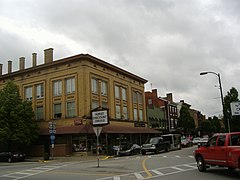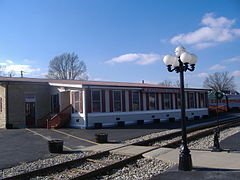Bardstown Historic District
The district consists of twenty-six blocks with a total of 279 properties. Over one third of the buildings in the district are Federal or Georgian architecture dating from the 1780s to 1850, reflecting Bardstown's status as one of the first towns in Kentucky, first settled in 1780 and formally established in 1788. Twenty-four of the blocks are in the initial grid pattern used to lay out the town's lots in 1797.
The town was originally to be called Salem when it was first settled in 1780 by 33 people, on land given as 1,000-acre (4 km) grant to John Owings and David Bard by Virginia governor Patrick Henry. Bard sent his brother William Bard to manage the holdings, and with William donating 2 acres (8,100 m) for a courthouse, the town was renamed Bardstown. In 1789 alone 150 log houses were built in the district. In the antebellum area the district became a cultural center for nearby localities, especially for Catholics; Bardstown had the largest concentration of Catholics of any town in Kentucky for a time. Its decline began when the Louisville and Nashville Railroad decided to initially bypass Bardstown, not building a railroad for the town until 1860, and not extending the line from Bardstown until 1887, after which Bardstown's population remained steady until it became the center of bourbon production.
At different times during the Civil War, commanders from both armies held their headquarters within the district.
The Old Courthouse, which lies in the center of the district surrounded by US 31E and US 150, was constructed in 1892 at the cost of $30,000. It now serves as the Visitor Center for Bardstown, with the new courthouse being built where the original Wal-Mart in Bardstown was located.
Thanks to the Nelson County Historical Society and the 1965 Historical District Zoning laws, much of the district retains its historical nature, save for a few commercial buildings along Third Street, also known locally as Louisville Road (which eventually reaches Louisville, where it is called Bardstown Road). By the 1980s over 200,000 tourists visited the town, which has steadily increased due to the continuing attractions of the Kentucky Bourbon Festival and My Old Kentucky Home State Park, located on the next hill to the east of the historic district.

United States President Jimmy Carter held a town hall meeting in the district in 1979.
Gallery
-
Shops along 3rd Street
-
Farmer's Bank & Trust
-
Backview of old Court House
See also
References
- ^ "National Register Information System". National Register of Historic Places. National Park Service. April 15, 2008.
- ^ National Register of Historic Places Map Metromapper.org, accessed August 31, 2008
- ^ Thomason, Phil. Bardstown Historic District NRHP Nomination Form (Thomason and Associates, 1982) Sec. 7, p. 0, Sec. 8, p. 0
- ^ Kleber, John E. The Kentucky Encyclopedia. (University Press of Kentucky, 1992). pp. 51, 52.
- ^ Thomason, Sec. 8, pp. 0, 1
- ^ Hibbs, Dixie Bardstown: Hospitality, History and Bourbon. (Arcadia Publishing, 2002) p. 156
- ^ Hibbs pp. 70–79
- ^ Thomason, Sec. 8, p. 2
- ^ Thomason, Sec. 7, p. 1
- ^ Kleber p. 52.






